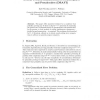Free Online Productivity Tools
i2Speak
i2Symbol
i2OCR
iTex2Img
iWeb2Print
iWeb2Shot
i2Type
iPdf2Split
iPdf2Merge
i2Bopomofo
i2Arabic
i2Style
i2Image
i2PDF
iLatex2Rtf
Sci2ools
ANTS
2006
Springer
2006
Springer
Doubly-Focused Enumeration of Pseudosquares and Pseudocubes
This paper offers numerical evidence for a conjecture that primality proving may be done in (log N)3+o(1) operations by examining the growth rate of quantities known as pseudosquares and pseudocubes. In the process, a novel method of solving simultaneous congruences-doubly-focused enumeration-- is examined. This technique, first described by D. J. Bernstein, allowed us to obtain record-setting sieve computations in software on general purpose computers. 1 Motivation In August 2002, Agrawal, Kayal,and Saxena [1] described an unconditional, deterministic algorithm for proving primality with time complexity (log N)10.5+o(1) . This result was later improved by Lenstra and Pomerance (described in [5]) to (log N)6+o(1) . Bernstein [6] (and independently Cheng [10]) then generalized an argument of Berrizbeitia [7] to produce a random-time primality provining algorithm with complexity (log N)4+0(1) . Given these results, an obvious question to ask may be: "how far can the time complexity ...
| Added | 20 Aug 2010 |
| Updated | 20 Aug 2010 |
| Type | Conference |
| Year | 2006 |
| Where | ANTS |
| Authors | Kjell Wooding, Hugh C. Williams |
Comments (0)

